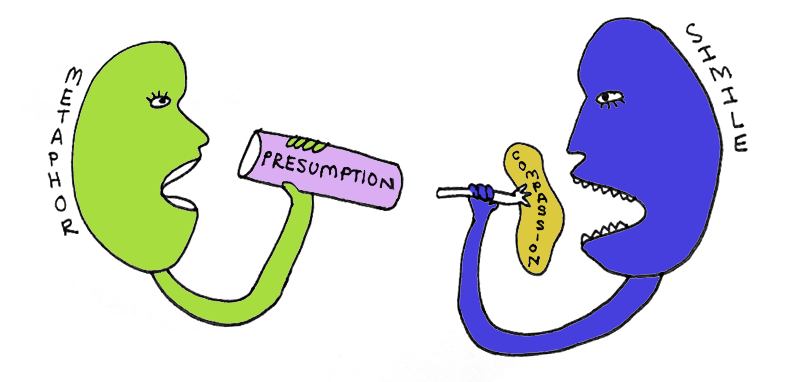Similes are intrusive, they beat you over the head, they’re cold and logical, they create distance. These complaints issue from poets as steadily as a river’s onrush, accompanied by their insistence that metaphors are superior. William Carlos Williams grumbled, “the coining of similes is a pastime of very low order, depending as it does upon a nearly vegetable coincidence.” Babette Deutsch in her Poetry Handbook echoes Aristotle when she suggests that similes are “less evocative” than metaphors. These are more reserved in expression but likely no less reserved in sentiment than the poet Jack Gilbert who said in an interview — and I can almost see him spitting the words — “goddamned similes, the weakest kind of resource there is in poetry. People are so much in love with similes. It’s a pity.” Ironically, it was over one of Gilbert’s own similes that a friend and I briefly debated the virtues and vices of them.
Every morning she was asleep in my bed
like a visitation, the gentleness in her
like antelope standing in the dawn mist.
(“Falling and Flying”)
Here one simile piggybacks another. Though it was not the visitation but those antelope that sparked debate. The simile calls me to enter and deeply consider the beauty and sensation of that gentleness. The immense distance which the gentleness attempts to leap across in the comparison opens with an expansiveness in which the dawn mist lingers. Not so for my friend or for some scholars who would call this a “false simile” because it’s counter to normal perception. For them, that distance breaks all ties between the subject and what it’s compared to. But some of the strongest and most striking similes — and metaphors — are counter to normal perception. Both figures implicitly call us to question assumptions, drawing us toward subtler associations and insights. Like clues in a mystery, they beckon us on to something beyond the obvious and quotidian. Consider Pound’s rightfully famous two-line poem, “In a Station of the Metro,”
The apparition of these faces in the crowd;
Petals on a wet, black bough.
How is that metaphor anything close to what we might call “normal,” whatever your definition of “normal” is? It’s the disparity that transfixes us. It’s not just the comparison, but the simultaneous similarity and contrast that holds the power in both figures. In a discussion about this very poem, Mark Doty commented that, “the further apart the elements within a figure are, the greater the tension and the greater the energy the metaphor has.” And this is true of similes as much as of metaphors. Though, it is interesting to note how in Pound’s poem those faces are consumed by the metaphor. They are ghosts nearly lost in their role as part of a “wet, black bough.” Their individuality is momentary like raindrops flashing through headlights during a downpour. Of course, this is part of the intention of Pound’s metaphor. But it is also more in the nature of metaphor than simile.
On one hand, metaphor is transformation, it’s Athene changing Arachne into a spider. But on the other hand, metaphor is assimilation, even destruction. Athene was cursing and not blessing Arachne, after all, and now the person is only a story behind the creature she became. If simile is cold and distant, then metaphor is passionate and consuming. This may be one reason we so passionately defend it. It’s the verbal equivalent of being sexually taken, which makes a more interesting story than the respectful simile asking if he may hold our hand while we walk. So metaphor does not apologize; it simply takes. Where two once stood, only one remains. If Shakespeare’s incredible “wrackful siege of battering days” in Sonnet 65, is powerful, it is so because the mind pickles the two parts in a kind of fog, an indefinite landscape. One cannot picture an army of days or a battering ram of time. To let any kind of image resolve fully in the mind is to lose the potency of the metaphor, which resides in a puissant ambiguity. By contrast a simile is more compassionate or respectful. If we feel, as Sartre famously said, that “hell is other people,” then the metaphor makes all others into us. It is an invasion of the body snatchers. But simile respects the boundaries of others and permits them to exist as themselves while allowing both comparison and contrast to extend vision. Metaphor is a colonization, while simile is a passport. Although the likeness in the two metaphors I just used is somewhat ironic and overstated, it is so to counter a universe of hatred. But to prove by example, here is a simile by Robert Lowell that carries as much power as Pound’s metaphor.
he drifts with the wild ice
ticking seaward down the Hudson,
like the blank sides of a jig-saw puzzle.
(“The Mouth of the Hudson”)
Pound’s metaphor lost individuals in the unity of an image, Lowell’s simile fragments into a landscape of irreconcilable disparities. The intellectual quality of Lowell’s simile, the fact that it deals with something that challenges the mind — a puzzle — reinforces the depth and complexity of the anxiety. The observer seeks meaning in his world but he finds instead of the challenge of something solvable, only the frustration of blank, indistinguishable pieces. He knows there are answers under everything he sees but nothing reveals itself. This anxiety runs through not only the external world but through his internal one; he doesn’t merely observe the ice fragments floating but “drifts with them.” As the poem concludes, the entire landscape is described as “unforgivable.” The speaker is in a kind of spiritual exile in his own world and that judgment is inherent in the simile from the first stanza.
Could this work better as a metaphor? I suggest it would not. The alienation of the observer is heightened by his inability to assimilate his world. Because he can’t make sense of the world around him, his internal world is also fragmented and senseless. Metaphors leap boundaries and unify. But here, the fragmentation is everything. The very fact of the fragmented psyche is heightened by the simile’s maintaining distinctions. Though internal and external worlds are dislocated and drifting, there is no reconciliation, no unity, though there is a similarity of state in both.
To return to the assertion that there is in simile only a “vegetable coincidence,” that is, that the whole weight of a simile rests on a resemblance and nothing more, here that similarity of ice fragments to the blank sides of puzzle pieces is not merely visual, but rather implies the entire world of meaning that we create by observation and association. The power of this can’t be overestimated in the push and pull of Lowell’s poem and certainly is far more than mere coincidence. Derek Walcott said he asked Lowell how long it took him to see the ice as these blank sides and Lowell’s response was that arriving at that vision was, “like pulling teeth.” It was nothing so easy as seeing a mere coincidence.
—but what’s lovelier
than the shapeshiftingtransparence of like and as:
clear, undulant words?
(Mark Doty, “Difference”)
Though Doty is rhapsodic about the two words central to a discussion of simile, I don’t mean this quote to be an assertion. What is more relevant is what he says further on in this same poem, and thus in the context of the beauty and importance of simile:
What can words do
but link what we know
to what we don’t
and so form a shape?”
That’s exactly it, no matter what trope is employed. It’s the business of language itself: not only to articulate the silence but give to “airy nothing a local habitation and a name.” That’s why, in a simile, when the disparity between the things compared grows almost to an absurdity, the background to it becomes a contrast that shocks us into understanding, like seeing Hokusai’s Great Wave off Kanagawa hanging in someone’s kitchen. Simile suggests the unity of all things while maintaining their distinctions. So I too — if I may be forgiven the indecency of quoting myself — have written in a poem, “the more a thing is known/the more it seems like other things.” Simile is knowledge: which itself is a common ground of different things, that is, distinctions understood within a single mind — the very functionality of simile. Of course, metaphor and all other figures of speech are forms of knowledge. But with powerful similes, its force lies in the disparity between the things compared, so the more striking that insight or feeling will be. As you narrow that disparity you move toward mere factual comparison or literal statement. And therein lies the difficulty, the hatred Gilbert expressed for the simile.
Someone once asked me what Sambuca tastes like and I said, “black licorice.” Here is the cold, logical, factual comparison that makes poets cringe at simile. The taste of Sambuca and black licorice aren’t like each other, they are identical because the main taste on the tongue is anisette. The comparison is almost a tautology, nearly as absurd as saying rain is like water. To be sure, the person who asked me to describe the taste of Sambuca understood what it tasted like but the quality of their knowledge was one-dimensional, an identity. His knowledge increased but the wealth of his world did not. Great similes, similes in poetry or prose as they should function, expand the world of our understanding, as though, suddenly, we were able to permanently see 10 miles farther than we ever could. In the right hands, that’s what they do.
Like as the waves make towards the pebbled shore,
So do our minutes hasten to their end
(Sonnet 60)
I stand on the shore and by Shakespeare’s simile, the waves crashing and sizzling at my feet are time, ticking away my own life in the watching. This does not need the dramatic insistence of metaphor. In fact, such a transformation would have made me balk since the image is impossible. Time is not waves of ocean water but to see it as like them is acceptable and marvelous. The gentle nudge of the simile opens the eyes. The image doesn’t violate the comparison, but maintains the distinction in a way that justifies by the clarity it conjures. We are taken in and under by the relentless insistence of the waves. In a way, the washing away of our lives becomes almost beautiful in its tragedy. A step further into the disparity between the object and what it’s compared to and we have Richard Brautigan’s poem “I Feel Horrible, She Doesn’t.”
I feel horrible. She doesn’t
love me and I wander around
the house like a sewing machine
that’s just finished sewing
a turd to a garbage can lid.
The whole point is the disparity, the distance between the function of a sewing machine and it doing something not only that it isn’t designed to do but doing something no one in their right mind would think to do. Who cares that sewing machines don’t “wander around”? It is the violation of a thing’s normal function that makes it possible to know exactly how the speaker feels: that in the vilest way the world is out of whack, nothing is right, now that “she doesn’t love me.” So when someone like E. W. Bullinger says simile “can hardly be called a figure, or an unusual form of expression” and reduces it to nothing more than the resemblance in a comparison, one wonders what worlds he’s missed by the limited scope of his definitions.
Comparison is the light of understanding that illuminates our world. It is both emotional and intellectual. It is both physical and transcendent. It moves like a wave, by polar correspondences that travel in sync, carrying to our senses comprehension of a reality otherwise lost in a sea of endless sameness. Comparison itself can come as simile, metaphor, analogy and other various tropes. And comparison isn’t reducible to likeness alone but expands to include contrast. The differences between things compared is as significant and vital as the resemblances to the things compared, just as in the Brautigan poem, just as in waves where the distance between the crest and trough differentiates a wave that gently laps the shore and a tsunami that levels a seaside city.
In Metaphors We Live By, George Lakoff and Mark Johnson asserted that “our ordinary conceptual system, in terms of which we both think and act, is fundamentally metaphorical in nature.” Since that book’s publication in 1980, research in cognitive sciences have been accumulating evidence proving them correct through studies of “embodied cognition.” The empirical evidence is that the structure of reason itself comes from our having a body. My emotions and thoughts may not inhabit space but because my body does, my spirits are lifted when I’m happy or when I understand your point I might say, “I see what you mean.” Such figurative landscapes are the true world we live and breathe in. In this way, even the phases of the moon are personal. So there is also a fundamental tie between Nietzsche’s insight that “Every philosophy is a philosophy of some stage of life” (66) and Proust’s madeleine moment. Both are rooted in a body’s response to its world and the reimagining of that world as its spiritual terrain. Indeed, Howard Moss showed in his marvelous The Magic Lantern of Marcel Proust how he learned from The Remembrance that memory is metaphor. The madeleine moment and all those similar moments throughout The Remembrance burst on Proust from a physical trigger because of the internalized association, that is, a comparison. Moss posits memory is metaphor because it “connects two things through some object or sensation by sensing a correspondence between them.” The arc and meaning of a life becomes real by echoing itself, the comparison and contrast of previous moments conjuring a theme that unites its seemingly disparate episodes. It is what gives the self unity and a history. So even the darkness we come from and go to is subsumed into Shakespeare’s “our little life, is rounded with a sleep.”
If we are such stuff as dreams are made on, it is not only because we die, but because the distance between the reality playing out in my head and the reality playing out in yours cannot be measured. We are, in many ways, worlds apart. Compassion, sympathy, empathy, is knowing that the one in my head is similar to the one in yours, though not identical. It’s simile that allows us to bridge that distance in any fashion. And “like” and “as” are not the only signifiers of distance and disparity, resemblance and contrast. One thing may echo another or mirror it. The steady stream reflecting the sky is as much a simile in the making as my conjuring in mind your pain at the death of your mother by recalling the death of my father and its associated pain. Of course, the power of imagination is greater than that since I could as easily magic into existence the feeling of my house burning down to sympathize with your loss, though this never happened to me. But again, this is the power of simile because I can imagine what it is like, though I am not you and have not experienced that. Here we might say metaphor would be presumption while simile is compassion. For I would not assume the reality of your loss in the way an actor assumes a role. It is your loss. And so “compassion” means “to suffer with” and not “in place of.” “Sympathy” means “to feel with” and not “in place of.”
In the essay, “Notes in Diary Form,” Williams asserts the primacy of a singular vividness against simile or any possible power in likenesses. The current of this idea runs parallel to the dominance of the image:
Poetry should strive for nothing else, this vividness alone . . . The realization of this has its own internal fire that is “like” nothing. Therefore the bastardy of the simile. That thing, the vividness which is poetry by itself, makes the poem.
It’s an incredible assertion because here he tiptoes around the door of gods and spirits. Counter to anything we know or can know, contrary to everything we understand or could compare things to that slouch toward us out of the dark, is the incomparable, the concept of the unique. At its extreme, the wholly unique is wholly incomprehensible. What can’t be compared to anything else is like an object that reflects no light, it’s essentially invisible. So the Bible tells us that “no man has seen God at anytime,” and the Tao Te Ching declares, “The way eternal has no name” (85). This is not about truth but a difference of natures. Spiritual nature is fundamentally different from physical nature, and there is no image for it, only approximations. So, the book of Luke tells us that the Holy Spirit descended on Jesus Christ “in a bodily shape like a dove” and the book of Acts, when the disciples spoke in tongues, indicates there appeared “cloven tongues like as of fire.” Simile here plays the role of interpreter between the invisible spirit and the physical world of mankind. But that was a world in which spiritual reality was understood as superseding the physical. Our time is an existentialist time where existence precedes essence. Thus the image dominates our poetry and metaphor is the dominant trope, even more for us than Aristotle. Naturally we will chant Williams’s, “no ideas but in things,” like a political slogan and agree with Joseph Brodsky when he says, “In poetry, as anywhere else, spiritual superiority is always disputed at the physical level.” It’s debatable, of course. But the more interesting moments are when poets approach these thresholds and, in an act of compositional honesty, allow simile and metaphor to tumble over one another like rivers of insight moving toward the unspeakable, similes and metaphors that, like Shakespeare’s “wreckful siege of battering days,” are not crisp images but physically weighted suggestions. They articulate reality without a definite picture.
. . . I wake
to the knowledge that things sunder
from themselves, like peeling bark,
to emptiness
of a bright silence shining after thunder.
(“A Simple Flame,” Chapter 13, V, Derek Walcott)
The enjambment pushes ever onward toward the ineffable. Right when the ear wants to linger and resolve on “peeling bark,” and the eye wants to luxuriate in the image, both are pushed on “to emptiness” and even when we want to stay there, as if at Eliot’s “still point of the turning world,” we are shoved on still further into “a bright silence shining after thunder.” It’s impossible here not to recall what the thunder said in “The Waste Land.” But it has faded into this shining silence. And the shining isn’t visible because silence can’t visibly shine. And since the thunder follows the lightening flash, we here enter the echo of the flash, something beyond sight rendered in a vision. However, like that vile disjointed world in Brautigan, we know what is meant and that is what is visible. It articulates the invisible that underlies appearances. It wears the light like a mantle to display what can’t be seen. It gives it a shape and a feeling in these words and now we can name it. The simile and metaphor tumbling together in a sweet honey that coats the rim of the medicine cup we drink: to face the fact of the nothingness at the center of all things.
Earlier I said that metaphor is better at unity. But simile is not inept when it comes to uniting. In one of the most elegant love poems of the 20th century, Bishop employs simile to unite heaven and earth:
The shooting stars in your black hair
in bright formation
are flocking where,
so straight, so soon?
— Come, let me wash it in this big tin basin,
battered and shiny like the moon.
(“The Shampoo”)
Metaphor introduces a concluding simile, yielding to it the preferred spot in the poem. Both tropes together forge a crucible in which heaven and earth mix. Lingering over these lines as a moon over the ocean tides, one feels pulled in both directions tempting the mind to see both the basin as a moon rinsing the stars, but also to see the moon as a basin in which our most common activities are bathed. Like children, we still wonder why the moon follows us as if we are special actors under its light. And, this poem intimates, we are. The famous lines from the Emerald Tablet tell us, “as above so below” and Bishop, here, tells us no less but with more intimacy and love. This simile functions in the opposite capacity to Lowell’s jigsaw pieces in “The Mouth of the Hudson.” His simile fragmented the world into its anxious shards both internally and externally. Bishop’s simile unites heaven and earth in the intimate activity of washing her lover’s hair. The disparity between the things compared fills with both love and the universe of things that are here just for their pleasure.
One theory of the fate of the universe is that it will continue to forever expand, energy being expended, heat shed through the vacuum to an equalizing stasis, stars fizzling out into an endlessly deepening and eternal darkness. We will never be as close as we are now to our neighbors. They will only continue to drift farther from us in time. But while there is time, we can cast large nets to encompass the different worlds into our metaphoric minds, we can travel the voids between us by the similes that are a kind of love. Like gravity, our similes are a force to pull us together even in our distinctions. What your world is like is one bridge I can use to travel to you. While the clock hands still go in circles, I can say what my day was like because it echoes yesterday and the day before. We can set up tuning forks at the same pitch of thought and emotion and in our minds, hum to the same key because your day was like and my day was like similarities we articulated in savory comparisons of bird flight and sunshine, cloud formation and music. Because the seasons repeat, I can find meaning and variation in a refrain: the decay of autumn leaves smelling like the fresh blossom of spring, a drop of melting snow on the fence petaled like the bud of a white rose, so that even in the midst of winter stasis, I can find my way to you and we can warm each other by the light of our language, burning like the final star in a dying universe. •
All illustrations by Isabella Akhtarshenas.







